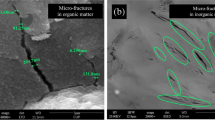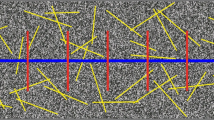Abstract
Shale gas reservoir is a complex multi-scale system containing micro-nanopores and micro-fractures. Understanding shale gas transport mechanism in fractured porous media is important to predict shale gas production performance accurately. This paper established a shale gas production prediction model, considering gas rarefaction effects, adsorption, diffusion, and stress sensitivity. The variation in production and drainage patterns with production time by multi-stage and multi-cluster fracturing considering fracture hit was studied by using this model. In addition, the influences of connecting hydraulic fractures, natural fracture conductivity, and stress sensitivity on shale gas production are discussed. When the spacing between the connecting fractures exceeds 4 stages (176 m), the production of the child well and parent well tends to be stable as the spacing between connecting hydraulic fractures increases. The child well production decreases, and the parent well production increases by considering fracture hits. The cumulative production of both parent and child wells increases with the increase in natural fracture conductivity. The results show that the production of parent and child wells considering stress sensitivity is, respectively, 14.31% and 18.73% lower than that without considering stress sensitivity. The key findings of this study can be expected to provide theoretical supports for the shale gas transport mechanisms in fractured porous media.












Similar content being viewed by others
Abbreviations
- D e :
-
Effective diameter of nanopores for gas transport, m
- k bulk :
-
Bulk diffusion apparent permeability, m2
- k f :
-
Permeability of the fractures, m2
- k k :
-
Knudsen diffusion apparent permeability, m2
- k m :
-
Permeability of shale matrix, m2
- k m0 :
-
Permeability at atmospheric pressure
- k s :
-
Surface diffusion apparent permeability, m2
- k vs :
-
Slip flow apparent permeability, m2
- M :
-
Gas molar mass, kg/mol
- n :
-
Number of moles of gas, mol
- n a :
-
Adsorption amount, mol/kg
- n 0 :
-
Maximum adsorption capacity, mol/kg
- p :
-
Pressure, Pa
- p L :
-
Langmuir pressure, Pa
- p 0 :
-
Gas pressure at a certain time during depressurization, Pa
- R :
-
Universal gas constant, Pa·m3/(mol·K)
- T :
-
Temperature, K
- T c :
-
Critical temperature of gas, K
- u :
-
Gas velocity in fractures, m/s
- u m :
-
Velocity, m/s
- V :
-
Volume, m3
- w f :
-
Fracture width, m
- Z :
-
Gas compressibility factor
- μ :
-
Gas viscosity, Pa·s
- ξ b :
-
Coefficient factor of adsorption gas for bulk gas transport
- ξ s :
-
Coefficient factor of adsorption gas for surface diffusion
- ρ g :
-
Gas density, kg/m3
- ρ r :
-
Shale density, kg/m3
- φ f :
-
Fracture porosity
- φ m :
-
Shale matrix porosity
- φ m0 :
-
Porosity at atmospheric pressure
References
Dong, J., Hsu, J., Wu, W., Shimamoto, T., Hung, J., Yeh, E., Wu, Y., Sone, H.: Stress-dependence of the permeability and porosity of sandstone and shale from TCDP hole-A. Int. J. Rock Mech. Min. Sci. 47, 1141–1157 (2010)
Geng, L., Li, G., Wang, M., Li, Y., Tian, S., Pang, W., Lyu, Z.: A fractal production prediction model for shale gas reservoirs. J. Nat. Gas Sci. Eng. 55, 354–367 (2018)
Jiang, J., Younis, R.M.: Numerical study of complex fracture geometries for unconventional gas reservoirs using a discrete fracture-matrix model. J.Nat. Gas Sci. Eng. 26, 1174–1186 (2015)
Langmuir, I.: The adsorption of gases on plane surfaces of glass, mica and platinum. J. Am. Chem. Soc. 40, 1361–1403 (1918)
Lee, S.J., Lee, K.S.: Performance of shale gas reservoirs with nonuniform multiple hydraulic fractures. Energy Sour. Part A: Recovery, Util. Environ. Effects 37(13), 1455–1463 (2015)
Lee, A.L., Gonzalez, M.H., Eakin, B.E.: The viscosity of natural gases. J. Petrol. Technol. 18(997–991), 000 (1966)
Lee, S.H., Lough, M., Jensen, C.: Hierarchical modeling of flow in naturally fractured formations with multiple length scales. Water Resour. Res. 37, 443–455 (2001)
Mahmoud, M.: Development of a new correlation of gas compressibility factor (Z-factor) for high pressure gas reservoirs. J. Energy Res. Technol. 136, 012903 (2014)
Monteagudo, J.E.P., Firoozabadi, A.: Control-volume method for numerical simulation of two-phase immiscible flow in two- and three-dimensional discrete-fractured media: simulation of flow in fractured media. Water Resour. Res. (2004). https://doi.org/10.1029/2003WR002996
Neto, L.B., Khanna, A., Kotousov, A.: Conductivity and performance of hydraulic fractures partially filled with compressible proppant packs. Int. J. Rock Mech. Min. Sci. 74, 1–9 (2015)
Ning, X., Feng, Y., Wang, B.: Numerical simulation of channel fracturing technology in developing shale gas reservoirs. J. Nat. Gas Sci. Eng. 83, 103515 (2020)
Olorode, O., Wang, B., Rashid, H.U.: Three-dimensional projection-based embedded discrete-fracture model for compositional simulation of fractured reservoirs. SPE J. 25(04), 2143–2161 (2020)
Ran, L., Gaomin, L., Jinzhou, Z., Lan, R., Jianfa, W.: Productivity model of shale gas fractured horizontal well considering complex fracture morphology. J. Petrol. Sci. Eng. 208, 109511 (2022)
Sharifi, M., Kelkar, M., and Karkevandi-Talkhooncheh, A. J. A. i. G.-E. R.: A workflow for flow simulation in shale oil reservoirs: a case study in Woodford shale. Adv. Geo-Energy Res. 5, 365–375 (2021)
Shi, Y., Song, X., Song, G.: Productivity prediction of a multilateral-well geothermal system based on a long short-term memory and multi-layer perceptron combinational neural network. Appl. Energy 282, 116046 (2021)
Sun, Y., Ju, Y., Zhou, W., Qiao, P., Tao, L., and Xiao, L. J. A. i. G.-E. R.: Nanoscale pore and crack evolution in shear thin layers of shales and the shale gas reservoir effect. Adv. Geo-Energy Res. 6, 221–229 (2022)
Wang, B., Fidelibus, C.: An open-source code for fluid flow simulations in unconventional fractured reservoirs. Geosciences 11(2), 106 (2021)
Wang, T., Tian, S., Li, G., Zhang, P.: Analytical model for real gas transport in shale reservoirs with surface diffusion of adsorbed gas. Ind. Eng. Chem. Res. 58, 23481–23489 (2019)
Wang, T., Tian, S., Zhang, W., Ren, W., Li, G.: Production model of a fractured horizontal well in shale gas reservoirs. Energy Fuels 35, 493–500 (2020)
Wang, L., Yao, Y., Wang, K., Adenutsi, C.D., Zhao, G., Lai, F.: Data-driven multi-objective optimization design method for shale gas fracturing parameters. J. Nat. Gas Sci. Eng. 99, 104420 (2022). https://doi.org/10.1016/j.jngse.2022.104420
Wu, K., Chen, Z., Li, X., Guo, C., Wei, M.: A model for multiple transport mechanisms through nanopores of shale gas reservoirs with real gas effect–adsorption-mechanic coupling. Int. J. Heat Mass Transf. 93, 408–426 (2016)
Xu, Y., Liu, X., Hu, Z., Shao, N., Duan, X., Chang, J.: Production effect evaluation of shale gas fractured horizontal well under variable production and variable pressure. J. Nat. Gas Sci. Eng. 97, 104344 (2022)
Yang, Z.-Z., Yi, L.-P., Li, X.-G., He, W.: Pseudo-three-dimensional numerical model and investigation of multi-cluster fracturing within a stage in a horizontal well. J. Petrol. Sci. Eng. 162, 190–213 (2018)
Yang, R., Hong, C., Huang, Z., Song, X., Zhang, S., Wen, H.: Coal breakage using abrasive liquid nitrogen jet and its implications for coalbed methane recovery. Appl. Energy 253, 113485 (2019)
Acknowledgements
The authors would like to thank the Research on Key Technologies for CUCBM's Production of 6 Billion Cubic Meters (CNOOC-KJ 135 ZDXM 40) for financial support.
Funding
This work has been funded by the Research on Key Technologies for CUCBM's Production of 6 Billion Cubic Meters (CNOOC-KJ 135 ZDXM 40).
Conflict of interestThe authors have not disclosed any competing interests.
Author information
Authors and Affiliations
Corresponding author
Additional information
Publisher's Note
Springer Nature remains neutral with regard to jurisdictional claims in published maps and institutional affiliations.
Supplementary Information
Below is the link to the electronic supplementary material.
Rights and permissions
Springer Nature or its licensor holds exclusive rights to this article under a publishing agreement with the author(s) or other rightsholder(s); author self-archiving of the accepted manuscript version of this article is solely governed by the terms of such publishing agreement and applicable law.
About this article
Cite this article
Li, B. Modeling of Shale Gas Transport in Multi-Scale Complex Fracture Networks Considering Fracture Hits. Transp Porous Med 149, 71–86 (2023). https://doi.org/10.1007/s11242-022-01835-y
Received:
Accepted:
Published:
Issue Date:
DOI: https://doi.org/10.1007/s11242-022-01835-y




